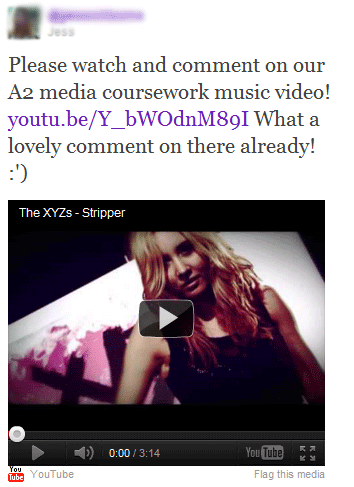To construct our music video, we used a video camera new to us all called a Sony HDV 1080i 3CMOS. We had previously not used a camera anywhere near as big as this for a media project so it was great to be able to try a new style of equipment.
This year we also used a new version of Adobe Premiere called CS5 which took a little getting used to as it was arranged slightly differently to the previous version used on last year's project. I personally now feel a lot more comfortable with Premiere as in previous projects there were more group members so I didn't get as much of a chance to edit.
We also used Adobe After Effects for the first time to colour grade and add effects like a vignette to our music video. I learnt how to use 'Curves' in order to play around with the brightness and contrast of a clip to make it look as professional and exciting and exciting to watch as possible.
Here is a video demonstrating our use of Adobe After Effects:
Designing our website was a new experience for all of us, as we had never used Wix before, and one that I primarily took charge of as part of our production work delegation.
 |
| The homepage was particularly challenging as we had to combine the software's own functions with custom HTML boxes for our social network links. |
We also made a QR code to place on our CD cover, website and possibly other products. Fans simply scan the barcode with their smartphone and will instantly be taken to a listen of The XYZs' links. In order to check everything worked, I used my own smartphone and barcode reading software.
Here is our QR code (feel free to scan - it works!):
Here is a short video demonstrating the barcode and our touch-screen website:
Throughout the research and planning stages of the project, we communicated amongst the group using several different forms of new media technologies. This included online social networks and smartphone applications like WhatsApp to ensure all three of us were always up-to-date with each other:
We did lots of online research, including using Spotify, YouTube and Last.fm when searching for a song to use by genre, style and similar artists.Throughout the evaluation stage of the project we utilised Web 2.0 to distribute our video and gain audience feedback. Firstly we held a screening of all 6 groups’ music videos in our school studio one lunchtime. We generated interest by posting a teaser trailer including all the videos on the school intranet homepage and on Facebook. We also created an event on Facebook and all three of us invited everyone we knew we to our school to invite them to come and watch our video:
We all also posted the video link on our personal Twitter and Tumblr pages in order to receive more feedback from outside our school and beyond the friends we knew personally, hopefully giving us more honest feedback:
This is the greatest advantage of using Web 2.0 to a standard viewing and questionnaire at school; there is potential to reach a worldwide audience, and we in fact received responses from Switzerland and Canada.Audience members who clicked on the video could then comment below the video, which was one way we received feedback. We also created an online survey using the website Surveymonkey: http://surveymonkey.com/s/qpqsl96
The site allowed us to read responses based on age, gender and music taste so we could pinpoint our target audiences and read their responses, and of course find out any improvements people think we should have made so we could evaluate effectively. It was a lot more simple and productive to use this site than hand our paper questionnaires, as results were instant and we could easily analyse all our results on one page without having to collate the information ourselves.














No comments:
Post a Comment